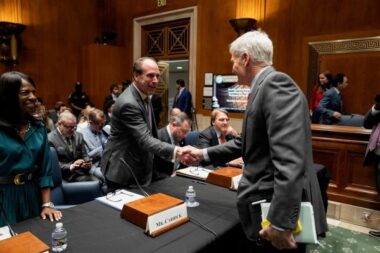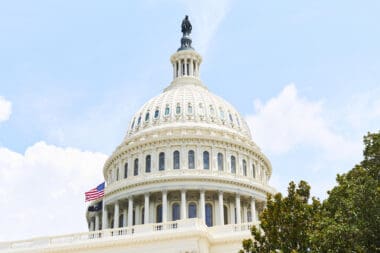MI to Senate: Strengthen the Federal Registered Apprenticeship Program

The federal Registered Apprenticeship program has the potential to help alleviate some of the manufacturing sector’s labor shortage—but it needs strengthening and streamlining to do so, Manufacturing Institute Chief Program Officer Gardner Carrick told the U.S. Senate Health, Education, Labor and Pensions Committee Wednesday.
What’s going on: “Registered Apprenticeship has an opportunity to play a significant role in the growth and scaling of the apprenticeship model in manufacturing,” Carrick said at the hearing “Registered Apprenticeship: Scaling the Workforce for the Future.” “But the program must be value-added.”
- In July, the MI—the NAM’s 501(c)3 workforce development and education affiliate—released “Manufacturing America’s Talent,” its workforce-system improvement roadmap that includes key recommendations for bettering the federal RA program framework.
FAME gives employers what they need: Apprenticeship works, Carrick said, pointing to the MI’s Federation for Advanced Manufacturing Education (FAME) program as evidence. FAME was started in 2010 by Toyota and is today fully run by the MI.
- But for the RA program to work as well—and help fill the many open manufacturing jobs, forecast to reach 3.8 million by 2033 if current trends continue—the federal government must provide flexibility to allow employers to tailor the program’s offerings to their real-world skill needs.
- The fact that just 15% of FAME participants are registered apprentices is evidence that the current system is not meeting needs, Carrick continued.
What should be done: The RA program “must be employer-led, offer a sensible balance between benefits and costs and support the infrastructure needs of our education partners to deliver the skills and competencies that manufacturers are actually asking for.”
What success looks like: Today, FAME works with nearly 500 companies in 45 locations across 17 states. Its graduates—highly skilled maintenance technicians—have a 95% full-time employment rate.
- One study shows that five years after finishing the program, FAME graduates were earning just under six figures annually, Carrick said.
- “In FAME, we achieve these levels of success because the model is employer-led, which means we teach the skills that employers actually demand.”
Read the whole thing: You can read Carrick’s full written testimony here.
Amazon Unveils New Innovative Robotics System
Amazon has a new package-sorting robotics system capable of doing the work of three separate stations “in one place,” the retail and technology giant announced recently (CNBC).
What’s going on: “The system, called Blue Jay, is made up of a series of robotic arms that are suspended from a conveyor belt-like track. Those arms are tipped with suction-cup devices that allow them to grab and sort items of varying shapes and sizes.”
The backdrop: The system is the latest in a lineup of robotics Amazon has begun using for an array of tasks, from removing goods from shelves to sorting packages. These investments not only make jobs more efficient, but they also increase safety for employees.
- In May, it unveiled “Vulcan,” a system that has a sense of touch.
- The company’s foray into robotics began in 2012, when it acquired Kiva Systems.
Employee-centered: Amazon, which plans to hire 250,000 workers for full- and part-time roles this holiday season, said “employees remain ‘at the center’ of its robotics development. … [and] its goal is to ‘reduce physically demanding tasks, simplify decisions and open new career opportunities’ for workers.”
Related development: Also recently, the global company unveiled augmented reality glasses for delivery drivers.
- The gadgets, which have been tested by hundreds of drivers, have artificial intelligence, cameras and sensors to scan packages and display hazards, driving directions and reminders.
- The glasses also feature a button drivers can use to call emergency services.
Housing Market Finds New Equilibrium Despite Mortgage Rates Weighing on Buyer Demand
In August, the S&P Cotality Case-Shiller U.S. National Home Price NSA Index recorded a 1.5% annual gain, the weakest annual gain in over two years. The 10-City Composite saw an annual increase of 2.1% in August, down from 2.3% the previous month, while the 20-City Composite rose 1.6% year-over-year, down from 1.8%. Among the 20 cities, New York again posted the highest annual gain at 6.1%, followed by Chicago at 5.9% and Cleveland at 4.7%. Tampa again recorded the lowest annual return, with prices falling 3.3%.
On a month-over-month basis, the U.S. National Index ticked down 0.3% before seasonal adjustment. At the same time, the 10-City and 20-City Composites both decreased 0.6%. After seasonal adjustment, the National Index and the 10-City and 20-City Composites all edged up 0.2%.
The combination of high financing costs and prices remaining near record highs has limited activity. Before seasonal adjustment, all cities except Chicago saw prices drop in August. The Midwest and Northeast markets continued to outperform other regions. Meanwhile, the Sun Belt and Western markets continued declining, including Tampa (down 3.3%), Phoenix (down 1.7%), Miami (down 1.7%), San Francisco (down 1.5%) and Denver (down 0.7%).
Despite high mortgage rates continuing to weigh on buyer demand, it appears the housing market is finding a new equilibrium. Several major markets in decline signal recent appreciation has ended. These adjustments may lead to a more sustainable market in the long run.
High Prices and Inflation Stay Top of Mind for Consumers
Consumer confidence decreased 1.0 point in October to 94.6. Among its components, the Present Situation Index improved while the Expectations Index declined, with consumers’ pessimism about future job availability and future business conditions being partially mitigated by consumers’ views of current job availability improving for the first time since December 2024.
The Present Situation Index, reflecting current business and labor market conditions, increased 1.8 points to 129.3. Meanwhile, the Expectations Index, which reflects consumers’ short-term outlook for income, business and labor market conditions, fell 2.9 points to 71.5, remaining below the recession signal threshold of 80 since February 2025.
Views of the current labor market situation improved, with 27.8% of consumers saying jobs were “plentiful,” up from September (26.9%), while 18.4% said jobs were “hard to get,” slightly higher than September (18.2%) and up from 14.5% in January. Looking to the future, 27.8% anticipate fewer available jobs in the next six months, up from 25.7% the prior month.
Mentions of high prices and inflation continued to top the list of topics influencing consumers’ views of the economy. Meanwhile, mentions of tariffs continued to decline in October but remained elevated. Comments on U.S. politics increased, with the ongoing government shutdown mentioned as a key concern. Consumers’ 12-month inflation expectations inched up from 5.8% to 5.9% in October. Meanwhile, 52.8% of consumers, compared to 51.1% in September, expect interest rates to rise, and a smaller share of consumers (26.2% vs. 26.9% in September) expect rates to fall.
Buying plans for cars increased in October, while buying plans for homes decreased. Consumers’ plans for buying big-ticket items were little changed in October but have started to pick up after weakening earlier this year. Consumers’ intentions to purchase more services rose after September’s pullback, and vacation intentions seem poised for a recovery. Preliminary data suggest consumers’ holiday spending will be down this year. Overall, consumers’ views of their current and future financial situation strengthened from September.
Fifth District Manufacturing Activity Declines, Price Increases Expected
Manufacturing activity in the Fifth District declined in October, but at a slower pace than the previous month, with the composite manufacturing index moving up from -17 to -4. Meanwhile, the local business conditions index increased from -12 in September to -1 in October. Despite improvements in most indicators in October, manufacturers are more pessimistic about the future, with the outlook for future local business conditions falling from -1 in September to -5 in October. The Fifth Federal Reserve District consists of Virginia, Maryland, the Carolinas, the District of Columbia and most of West Virginia.
Among its components, shipments moved into positive territory, rising from -20 to 4. New orders and employment remained negative but contracted at a slower pace, stepping up to -6 and -10, respectively. The vendor lead time index declined from 10 to 6 in October. Meanwhile, the share of firms reporting backlogs eased, moving from -21 to -16. The average growth rate of prices paid and prices received both fell in October.
Looking ahead, firms still expect both price indexes to increase in the next 12 months, but with both rising at a slower rate than forecasted in September. Expectations for future shipments jumped from 0 to 13, while new orders increased from 8 to 12. Expectations for backlogs worsened, falling from -8 to -12. Meanwhile, firms’ expectations about equipment and software spending remained negative but improved from -9 to -6. Expectations for capital expenditures moved into positive territory, increasing from -11 to 1. In sum, businesses in the Fifth District are somewhat more optimistic about new investment plans while remaining cautious about future business conditions.
Federal Reserve Judged That Downside Risks to Employment Warranted an Additional Interest Rate Cut
The Federal Open Market Committee lowered its interest rate target range by 25 basis points to 3.75%–4.00% at its October meeting. The FOMC also concluded its multiyear reduction of its Treasury holdings but will continue to shrink its holdings of mortgage-backed securities. In a change to its previous statement, the FOMC noted that inflation has moved up some since earlier this year, but available indicators suggest that economic activity continues to expand at a moderate pace. Nonetheless, the committee judged that downside risks to employment warranted an additional cut to its interest rate target. Two FOMC members—Stephen Miran and Jeffrey Schmid—dissented. Miran preferred to lower the target range by 50 basis points, while Schmid preferred to keep the rate steady.
In the press conference following the meeting, Federal Reserve Chairman Jerome Powell noted that the data that have remained available suggest that the outlook for employment and inflation has not changed much since their previous meeting, with conditions in the labor market cooling while inflation remains elevated. Chairman Powell also noted that a further reduction in the policy rate at the December meeting is not a forgone conclusion—“far from it.”
The FOMC’s summary of economic projections, which maps out the Federal Reserve’s expectations for where interest rates may be headed in the future, generally is released in conjunction with every other FOMC meeting. Since the September meeting included a release of economic projections, there was not a release in conjunction with the October FOMC meeting. The September summary signaled a more dovish stance than the June summary. Although nine Federal Reserve officials projected an additional 50 basis points worth of cuts in that projection, implying the likelihood of a December cut, Chairman Powell expressed that policymakers now bring “strongly different views about how to proceed.”
Manufacturers to Congress: Pass a Clean Continuing Resolution and Reopen Government Now

Every day that the government remains closed is another day “the American people suffer new losses, and businesses remain stuck in neutral”—so Congress must end the shutdown now, the NAM and its official state partners told Senate and House leaders on Tuesday.
What’s going on: “An open and fully functioning government is essential to the growth of the American economy, the success of manufacturers across the country and the well-being of our communities,” the NAM and more than 30 of its state manufacturing association partners explained to Senate Majority Leader John Thune (R-SD), House Majority Leader Steve Scalise (R-LA), Senate Minority Leader Chuck Schumer (D-NY) and House Minority Leader Hakeem Jeffries (D-NY).
- “When the government is shuttered, it stifles our ability to invest in our communities and our people. And it diminishes faith in our institutions.”
The impact: The shutdown, which entered its 29th day on Wednesday, has furloughed hundreds of thousands of federal workers and halted critical safety inspections of new power plants and manufacturing facilities.
- Life-sustaining products aren’t getting to Americans who need them, and desperately needed new power sources aren’t being added to the grid, the groups continued.
- Furthermore, “[p]ermitting becomes next to impossible, and housing projects, retail construction, data centers, manufacturing production lines, infrastructure projects and other job-creating investments cannot break ground.”
What must be done—immediately: The government must reopen “without further delay, and a clean continuing resolution is the swiftest and most effective way to achieve that,” the organizations told the congressional leaders.
Driving the news: In an exclusive to Fox Business, who covered the letter, NAM President and CEO Jay Timmons laid it out plainly:
- “Every day the government is closed, job-creating projects are stalled, supply chains are disrupted, permits halted, product approvals and facility inspections are delayed and safety approvals on which American families rely are put on hold.
- White House Deputy Press Secretary Abigail Jackson also amplified the Fox Business story on X.
NAM to Congress: Reform the 340B Program

The NAM called on Congress this week to reform the 340B program, which drives up health care costs—one of manufacturers’ top concerns as reported in the NAM Q3 2025 Manufacturers’ Outlook Survey.
What’s going on: On Thursday, the Senate Health, Education, Labor and Pensions Committee held a hearing titled “The 340B Program: Examining Its Growth and Impact on Patients.” In advance of the hearing, the NAM detailed for Chairman Bill Cassidy (R-LA) how the program has increased health care costs for manufacturers.
- The NAM noted that “the expansion of this program was associated with approximately $23 billion in additional employer-based health care expenses in 2023, of which employees paid about $4.5 billion per year in added insurance premiums. That equals approximately $137 in additional annual premium costs for single coverage and $415 for family coverage.”
Congressional intent: The 340B program was created “to provide lower cost medicines and expand care for low-income and underserved patients, but many covered entities have taken advantage of the program to increase their profits, which has in turn increased the cost of [employer-sponsored insurance].”
- “Manufacturers believe the 340B program is an important tool in expanding care for underserved communities, and we urge fundamental changes that would restore this program to its core purpose.”
Solutions oriented: The Health Resources and Service Administration is in the process of standing up a 340B Rebate Model Pilot Program, on which the NAM submitted comments.
- “This pilot program is a critical first step in enhancing program integrity and transparency in a way that makes the 340B program work for everyone but will not be fully sufficient in reforming the 340B program,” the NAM told the HELP Committee.
Next steps: The NAM suggested that reforms to “current fee structures, third-party administrator behavior, sub-grantee eligibility and how patients benefit from the program.”
- “Additional reforms, such as patient definition and child site eligibility, will also return the program to the intent with which Congress created it.”
EU’s Due Diligence Mandate Threatens America’s Manufacturers

A sweeping new European Union regulation could saddle America’s manufacturers with costly red tape—undermining U.S. sovereignty and manufacturing growth here at home.
What’s happening: The EU’s Corporate Sustainability Due Diligence Directive, approved by the Council of the European Union in 2024, has prompted calls from both U.S. and European companies as well as several EU nations for the European Parliament to scale back this unworkable and extraterritorial mandate.
- EU nations must act: Member states are required to translate the directive into national law by July 2027.
What it is: CSDDD forces companies to identify and mitigate potential social and environmental risks across every stage of a product’s life cycle—from sourcing to disposal.
- Extraterritorial impact: While EU lawmakers have proposed to reduce the number of non-EU companies that would be subject to CSDDD, the latest proposal would still apply to U.S. companies that have more than 1.5 billion euros in net annual EU turnover.
- Deep reach: Companies subject to CSDDD will be responsible for the actions of their direct business partners and will have to assess the risks posed by their indirect business partners if there is a prospect of an adverse impact. As a result, the directive’s requirements could stretch deep into manufacturers’ supply chains, implicating small, privately held and non-EU businesses.
Why it matters: The directive would impose sweeping due-diligence requirements on U.S. companies with EU ties—and even those indirectly connected through supply chains.
- Compliance squeeze: The scope of the burdensome mandate would introduce significant operational complexity, compliance costs and potential for bottlenecks and delays throughout the complex, global manufacturing supply chain.
- Liability risk: CSDDD would also expose manufacturers to significant legal liability, as the directive allows EU nations to impose penalties of up to 5% of a company’s global turnover.
What’s at stake: Manufacturers already face nearly $350 billion in annual regulatory costs at home. CSDDD would add to this burden—subjecting America’s manufacturers to job-killing European red tape and ceding U.S. regulatory authority.
- It would undermine the Trump administration’s progress on regulatory modernization, a priority the NAM has championed from the start.
What’s next: President Trump has rightly flagged CSDDD as a threat to the trading relationship between the U.S. and the EU, and the U.S.–EU framework agreement announced earlier this year prioritizes addressing concerns about the impact that CSDDD would have on U.S. companies.
- The EU has been considering revisions to CSDDD but has not addressed some of its most damaging aspects, including its extraterritorial provision that would apply to manufacturers in America and their suppliers. The Legal Affairs Committee of the European Parliament failed to remove that provision in its recent compromise omnibus legislation. U.S. policymakers should take note as this compromise legislation advances through the EU’s process.
The bottom line: “CSDDD would impose significant, extraterritorial burdens on America’s manufacturers,” said NAM Managing Vice President of Policy Charles Crain. “Manufacturers appreciate the Trump administration standing up for our industry on the world stage, and we urge both American and European policymakers to protect U.S. companies from this costly and unworkable burden.”
Call to action: Tell Policymakers: Stand Up for America’s Manufacturers on the World Stage.
Related News: The NAM and top business groups have issued an urgent call to the Trump Administration to push back against the EU’s harmful Corporate Sustainability Due Diligence Directive (CSDDD), warning that the measure could impose “nearly $1 trillion” in compliance costs and undermine U.S. sovereignty. Read the letter.
DHS Should Reconsider Proposed F-1 Visa Changes

With nearly 400,000 jobs open across the sector, the manufacturing industry in the U.S. needs ongoing access to a robust pipeline of skilled workers—but changes proposed to the F-1 student visa by the Department of Homeland Security threaten to reduce the talent in that pipeline, the NAM said recently.
What’s going on: “The F-1 visa … through its Curricular Practical Training (“CPT”) and Optional Practical Training (“OPT”) and STEM OPT options is a major source of high-skilled talent for the manufacturing industry in the U.S.,” the NAM told DHS in response to the agency’s draft reforms to the visa program.
- “[T]he proposed rule would impose changes that risk diminishing the appeal of an American education, making it harder for students to transition into careers that strengthen U.S. manufacturing. This would have a negative impact on the growth and international competitiveness of manufacturing in the United States, which is at odds with President Trump’s objective to bolster the domestic industry.”
What’s at stake: The primary change under consideration “is the switch of F-1 student visas from a duration of status (“D/S”) that remains in effect for as long as the student is enrolled in an academic program to a fixed time period that corresponds to the program’s length but cannot exceed four years.”
- “This would significantly diminish the attractiveness of U.S. universities for prospective international students, because it is at odds with the length of time that many if not most students take … to actually earn their degrees.”
- That change would also make it harder for international students to secure OPT or STEM OPT extensions, in turn inhibiting their “transition into the U.S. manufacturing workforce.”
Why it matters: “These proposed changes … would weaken manufacturers’ access to a plentiful pool of elite global talent upon which we depend to fulfill President Trump’s vision for a manufacturing renaissance in America,” the NAM concluded.

